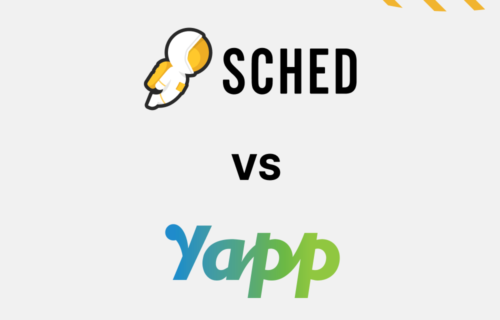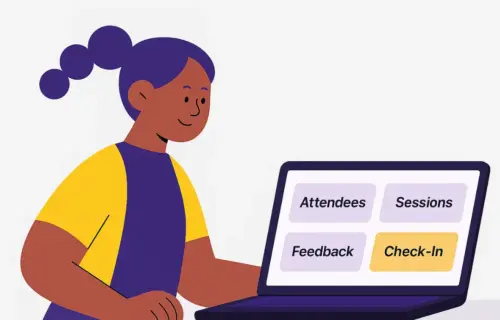It’s 7 p.m. You’re buried in spreadsheets and long email threads, wondering how you’ll finish planning tomorrow’s professional development day before the staff meeting. Been there?
Running school events shouldn’t feel like a second job.
If planning your next PD day, parent night, or student showcase has you buried in emails and spreadsheets, it’s time to simplify.
This guide walks through how K–12 leaders like you plan standout events in half the time, with none of the complications.
Key Takeaways:
Table of contents
- The first step in optimizing times when planning a school event is identifying where you’re wasting the most hours, and how to avoid it.
- Simplifying proposals submission, speeding up registration and check-ins, having a centralized hub for scheduling and automating the gathering of feedback are some of the changes you can make to plan school events faster.
- Hundreds of K-12 schools have saved hours of event planning by using Sched.
What’s Slowing You Down? The Biggest Time Drains in K–12 Event Planning
Planning events like PD days, back-to-school nights, or district conferences takes a lot of work and time. Between tight schedules and limited resources, these are the biggest tasks that eat up hours from your schedule:
- Collecting and reviewing proposals manually: Sorting through Google Forms or email submissions and searching for missing details feels like herding cats.
- Unorganized registration: Paper sign-ups or manual RSVPs lead to errors and endless follow-ups.
- Schedule changes: Last-minute changes mean updating printouts or firing off emails, leaving attendees confused.
- Scattered communication: Attendees tend to ask the same questions because event info is dispersed across flyers, emails, and websites.
- Manual attendance and feedback: Tracking check-ins on paper and compiling post-event surveys by hand can be a hassle.
To get that time back, many K–12 teams are adopting centralized event management platforms. Tools like Sched help schools move away from manual, disconnected systems, making event planning faster, more organized, and easier to manage across teams.
6 Tips to Plan K-12 School Events in in Half Without Cutting Corners
Here’s how to reduce your planning time while improving the experience for your team and attendees.
Tip 1: Simplify Session Proposals
Proposals submitted through emails or Google Forms can get messy. A built-in call for papers tool lets you collect and review session proposals in one place.
You’ll save valuable time previously spent on emails and folders. That’s how schools like Wake County Schools succeeded in handling 200+ proposals efficiently.
Tip 2: Make Registration Effortless
Manual sign-ups are a thing of the past. Online registration with automated sign-ups, confirmations, and customizable forms is what attendees now expect.
Save hours typically lost to fixing manual registration errors or follow up on RSVPs by having a digital registration platform. It allows you to simply import attendee lists, offer multiple payment options, and create branded sign-up pages that reflect your school or district’s identity, no IT help required.
Tip 3: Build Schedules with Ease
Creating schedules shouldn’t mean endless reshuffling. A central scheduling software can let you set room capacities, manage waitlists, and adjust for last-minute changes in minutes.
Attendees can stay on the same page and get mobile-friendly views, while you minimize manual updates and confusion on the day of the event.
Tip 4: Centralize All Event Info
Scattered information leads to repetitive questions. A custom event page can hold session materials, speaker bios, and schedules in one place. Attendees can build personalized schedules and get real-time notifications for updates.
In addition to the time you’ll save by having event details readily available to attendees, your event will seem more polished, especially if you also have a mobile app.
That’s exactly how WEMTA’s 3-day conference participants were able to click into Sched, create their own schedule, and look at other sessions within the framework.
Want to offer the same seamless experience? Try Sched for free and see how easy it is to keep everyone on the same page.
Tip 5: Speed Up Check-Ins
Paper sign-in sheets are slow and messy. And if your event has multiple entry points, they’re even harder to manage.
You can use QR codes or self-check-in to track attendance in real time. You’ll speed things up and also get instant visibility during the event, and useful data afterward.
Tip 6: Collect Feedback Automatically
Post-event surveys don’t have to be a chore. You can automate this time-consuming process by gathering feedback that’s session-specific, prompts attendees and asks custom questions.
This makes it easier to improve your next event, and show impact to your leadership team.
Improve Your Events with Sched to Make Space for What Really Matters
Cutting planning time doesn’t mean cutting corners. Sched gives you the tools to create a professional experience by:
- Saving time through automation: Repetitive tasks like asking for post-event feedback can be time-consuming. Automating these lets you focus on strategy and engagement.
- Having better attendee experiences: It’s easier to keep attendees engaged and informed if they have mobile-friendly schedules, receive real-time updates, and get personalized agendas.
- Making decisions backed by data: You can demonstrate value and improve future events by tracking attendance patterns and proving event ROI.
All this without adding to your already overloaded schedule. It’s like gaining a teammate who handles the heavy lifting, so you can focus on creating the kind of impact that lasts.Take back your time. Start your free trial of Sched and plan your next event in hours, not days.








